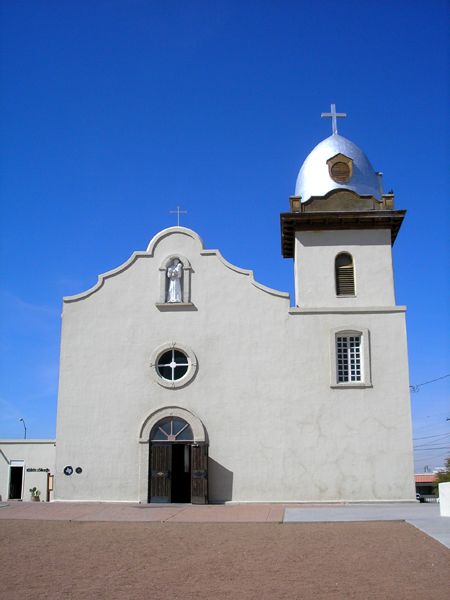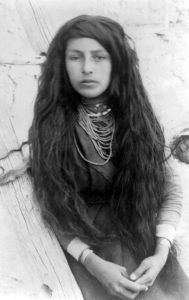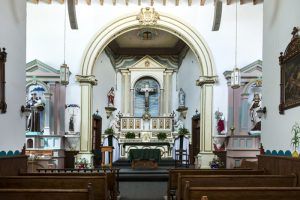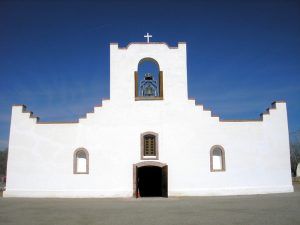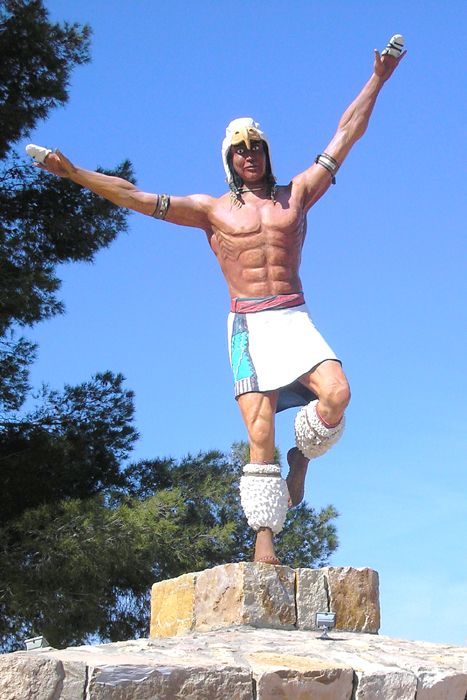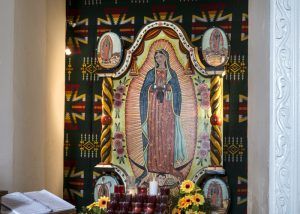The Ysleta del Sur Pueblo and the Mission Corpus Christi de la Ysleta, located just southeast of El Paso, Texas, is the oldest continuously operated parish in the state. The community claims to have the oldest continuously cultivated plot of land in the United States.
The mission was established by Antonio de Otermín, the Spanish governor of present-day New Mexico, and Fray Francisco de Ayeta in 1682, after refugee and captive Tigua (Tiwa) Indians came to the area following an unsuccessful attempt to recover the territory following the Pueblo Revolt of 1680.
Before arriving in present-day Texas, the Tiwa had faced many challenges in the past several hundred years, including fighting the fierce Apache Indians and in two wars with the Spanish — the Tiguex War in the winter of 1540-41 and the Pueblo Revolt of 1680. After the revolt in 1680, Governor Antonio de Otermín made an unsuccessful attempt to recover the territory in the winter of 1681-82. During this attempt, the Isleta Pueblo was stormed, and about 500 Indians were taken captive, marched to El Paso, Texas, and soon settled at the new Pueblo of Ysleta del Sur. Other Indian and Spanish refugees soon followed.
The original mission church at Ysleta del Sur is believed to have been built of mud-chinked logs and willow reeds, and the first Mass was celebrated on October 12, 1680. Later, Tiwa labor built a more permanent mission church from adobe which was consecrated in 1682. It was named La Misión de Corpus Christi de San Antonio de la Ysleta del Sur in honor of the Tiwa’s patron saint, Saint Anthony (San Antonio). Franciscan priests administered the mission.
Ysleta soon became a meeting and mixing place, partly because of its location near the river and the gateway to the New Mexican settlements along the El Camino Real de Tierra Adentro National Historic Trail.
In 1692, Governor Diego de Vargas, en route to reclaim New Mexico for the Spanish Crown, more formally recognized the community in 1692, when he bestowed a formal grant to the mission and surrounding lands. With Vargas’s re-establishment of the province, some Tigua and Spanish residents of Ysleta del Sur returned to New Mexico. Afterward, the church was renamed Corpus Christi de los Tiguas de Ysleta, and the building of a traditional pueblo with a plaza and ceremonial kiva began. However, the local Indians and Spanish referred to the mission church as San Antonio de Padua.
Ysleta was swept away in the flood of 1740, but by 1744, it had all been rebuilt. Despite the challenges of frontier living, Ysleta del Sur moved into the early 19th century as a community of successful farmers and artisans whose pottery, baskets, textiles, and other traditional arts were frequently traded along El Camino Real. The government transition from Spain to Mexico in 1821 increased trade along the newly opened Santa Fe Trail. Many goods traveled down El Camino Real, then known as the Chihuahua Trail, while Anglo-American settlers were drawn to the region.
In 1829, a massive flood changed the Rio Grande’s course and set Ysleta del Sur and its neighboring communities of Socorro del Sur and San Elizario on the river’s north bank. The flood heavily damaged the 1744 mission. By the time it was restored, Ysleta del Sur was under the governance of the United States and situated in the State of Texas. The missions then passed from the jurisdiction of the Bishop of Durango, Mexico, to that of the newly established Diocese of Santa Fe, New Mexico. The Franciscan friars then abandoned Ysleta and the nearby Socorro Mission and returned to Mexico.
Bishop Jean Baptiste Lamy, the first Bishop of Santa Fe, recruited French diocesan priests to come to Ysleta and Socorro. They served the parish until 1881. The most notable action by the French clergy was the petitioning of a change of name of the parish from San Antonio to Our Lady of Mount Carmel. Unaware or unconcerned of the opposition of the name change by the Pueblo residents, the name was officially changed in 1876. However, the Tigua members of the community continued to, and still honor, San Antonio de Padua as the patron of the Mission. The church’s traditional Spanish New Mexican architecture also saw extensive alterations, including changes to the facade and the addition of a grand bell tower dome.
In the meantime, new roads, mail, and stagecoach routes were merged into El Camino Real and expanded the community’s commercial, social and cultural connections. Another flood damaged the mission church in the mid-1850s, but a new church, with its current dimensions, was soon established on a raised platform.
In 1881 the Jesuits took over the church serving the parish for the next 110 years. One of them, Father Pinto, was influential in developing many more missions and parishes in the region, as far away as Carlsbad, New Mexico.
Fire severely damaged the structure of the mission church in 1907, burning the roof’s vigas structure away. Parts of the mission walls and the sacristy, a church bell, and a cherished Spanish statue of Santo Entierro (Christ Interred) survived the fire. The building was repaired by 1908 with an arched entrance door, a narrower tower, and only one façade niche. The bell in the Mission Plaza is one of the surviving original bells.
In 1990 members of the community began efforts to restore and preserve the Ysleta and Socorro missions and the Presidio Chapel of San Elizario, Texas. With the help of city and county governments, the Catholic Diocese, private organizations, and the National Park Service, restorations began on the old mission churches that comprise the El Paso Mission Trail today. The trail stretches approximately nine miles along Socorro Road (FM 258) and follows a portion of the El Camino Real de Tierra Adentro (The Royal Road to the Interior).
In 1991 Bishop Peña of El Paso transferred the responsibility of Ysleta Mission to the Conventual Franciscans who continue to staff the parish today.
The Tigua are members of a federally recognized tribe and sovereign nation and the only Indian pueblo in Texas. Ysleta del Sur’s native peoples maintain a strong presence in the lower El Paso Valley. The Ysleta Mission remains a spiritual hub of the Tigua people who observe several ritual days with dancing, drumming, and chanting. The principle of those days is the Feast of St. Anthony of Padua on June 13.
Inside the mission, statues of St. Anthony and Kateri Tekakwitha, the Catholic Church’s sole American Indian saint, share close quarters. Native motifs — rain clouds, corn stalks, baskets, blankets, and more — flow through the church’s neoclassical interiors, providing an unexpected contrast to its Spanish Colonial Revival facade. Outside, El Camino Real runs along Socorro Road to the east.
The mission church is open to the public daily.
More Information:
Ysleta Mission
131 South Zaragoza Road
El Paso, Texas 79907
915-859-9848
©Kathy Weiser-Alexander/Legends of America, updated November 2021.
Also See:
El Camino Real de Tierra Adentro National Historic Trail
Spanish Missions & Presidios Photo Gallery
Tiwa (Tigua) Tribe – Fighting the Spanish
Sources:
Spanish Missions – National Park Service
El Camino Real de Tierra Adentro – National Park Service
Wikipedia
Ysleta Mission

